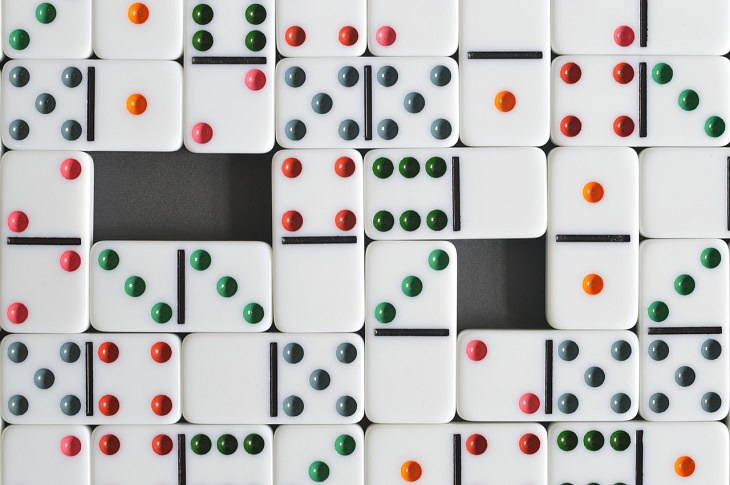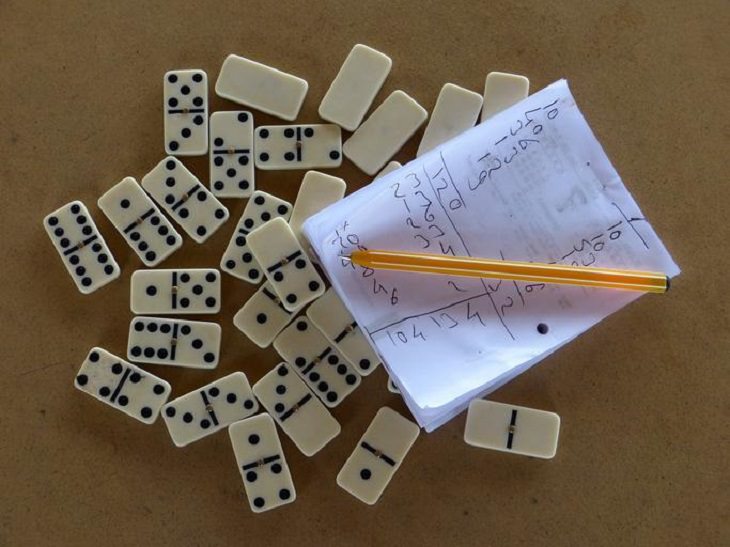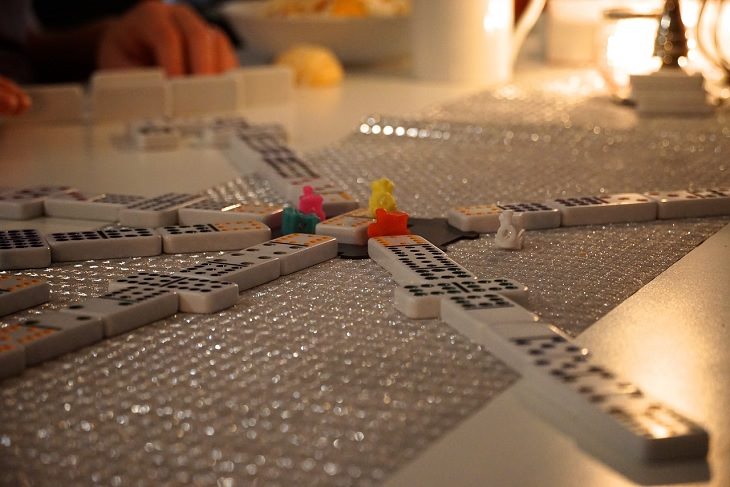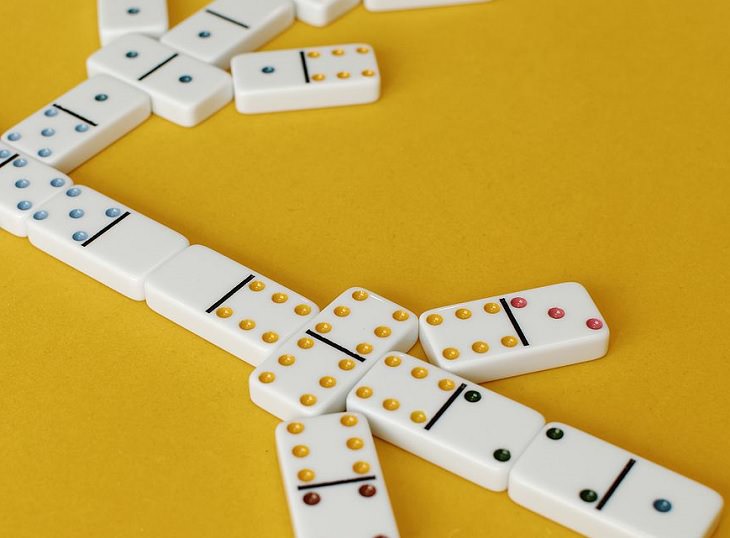
There may be nothing quite as satisfying in this world as watching an intricately crafted train of multicolored dominoes topple. Falling dominoes have been a staple of both the gaming world and the art world for a good many years. However, before people discovered the sheer delight that could be experienced watching domino displays, dominoes were originally used to play a myriad of games that were and still remain today equal parts challenging and fun. Dominoes are more than just material for creating art, with sets of brightly colored tiles that can be endlessly stacked. While older games played with dominoes stuck to simple rules, today we have fascinatingly fun ones like Chicken Foot and Mexican Train that can be played by almost every age group, young and old. Let’s take a look at the modern and fun side of these historical and artistic game pieces!

Dominoes have reportedly been around in China since the 13th century, with the first appearance of modern-day dominoes occurring in 18th century Italy. These rectangular tiles consist of two square ends, each marked with a number of dots called pips or nips. They were previously made out of ivory, ebony, crystal, glass, or stones like granite or marble. Domino sets were often sold and used as playing cards, with a variety of games for players to choose from, usually requiring players to match squares with the same number of nips, a rule which still largely stands with certain variations. Today, most dominoes are made out of various woods, or plastic, with a little color thrown in to give it a bright twist.

Taking things a step further than the average card game, dominoes come in varying levels of difficulty and complexity depending on your preference. The most common Domino sets are double 6 sets, where the highest number of nips (dots) on either/both squares of a tile is 6 and there are 28 tiles in a set. For more players or a bigger challenge, there are also double 9 sets, double 12 sets, double 15 sets, and double 18 sets, which come with 55, 91, 136, and 190 tiles respectively. You can build quite the collection of dominoes with these sets. And when you get bored of lining them up and watching them tumble, you absolutely have to give these games a try!
Block is a very simple but still entertaining game. It is played in multiple rounds and can be played with 2-4 players when using a double 6 set. If there are 2 players, each begins by drawing 7 tiles. In the case of more players, each must draw 5. The remainder of the cards goes to the “boneyard”. In Block, no cards may be drawn from the boneyard. The game Draw has the same rules as Block but allows cards to be drawn during each round, extending them till the boneyard runs dry.
Each round begins when the player with the highest double, the tile which has the highest number held by all players on both tiles (example: a tile with 6-6 or 5-5), plays that tile. Moving clockwise, each player then plays a tile on their respective turn that has a square with a number matching that of a played square. That is, if the game begins with 6-6, followed by 6-2, the third player could play another tile with a 6 square, or a tile with a 2 square.
While tiles can be played vertically or horizontally, all tiles must stay in a single line. Double tiles can be placed adjacent in a crossover manner, but it is not mandatory in this game. The round continues until one player has no more tiles in their hand or until there are no more plays that can be made.

The goal of the round is to have the “lightest hand”, i.e., tiles with the lowest valued squares in their hands. At the end of each round, the person with the lightest hand, which could be the player with no tiles left, or in case all players still have tiles then the one with tiles that have the lowest numbers is considered the “winner” of the round.
The winner is accordingly awarded points for that round which are calculated by adding the total value of tiles in the other player's hands minus the points in his/her hand. In case of a tie, the person with the lowest valued individual tile is declared the round’s winner. At the end of all rounds, the total points collected in each round are tallied to determine the final winner.

This game is very similar to the card game and requires a steady combination of luck and good memory. It can be played with 2-4 players using a double 6 set. For a higher number of players, a higher valued set (like double 9 or double 12) is required. It is a simple and fun game, perfect for kids to test their addition skills. The game begins by thoroughly shuffling the tiles and then placing them face down on the table in a 4 x 7 grid.
The first player, who can be decided in a manner of your choosing, starts by selecting and turning face up any 2 tiles on the grid. If the numbers on the tiles turned over add up to 12, for example, 1-1 and 4-6, the player can remove those two tiles from the grid and place them aside in his/her own pile. He/she can continue their turn by selecting two more tiles.

If the two tiles selected do not bear numbers that add up to 12, the tiles are flipped back over on the grid, and the next player gets their turn. In case a double 9 set of dominoes are being used, the numbers must add up to 18, and with a double 12 set, the numbers must add up to 24.
Each round ends when the last pair of tiles have been removed from the grid. The points scored and the winner of the game can be determined in two possible ways. The first simply awards the round to the player to remove the final pair of tiles, and the game continues until a player wins a certain number of rounds, like 10. The second awards a point to the players for each pair of tiles removed by them, with multiple rounds being played until a player earns a certain number of points, like 30.
This is a quick-paced game, fun to be played in larger groups, up to 10 people, and with a double 12 set, as seen in the video, though for groups of 4 or less, a double-6 set works just as well. It is meant to be played in rounds each of which begins with a descending number of doubles, i.e., 12-12, 11-11, 10-10…, or in the case of a double 6 set, 6-6, 5-5...
All the tiles must be shuffled and placed face down on the side in the “boneyard”, except for the starting double tile, which will be 12-12/6-6 (double 12 set/ double 6 set) for round one. After deciding the first player, the starting double tile is placed in the center of the table between the players, and each player draws 10/5 tiles from the boneyard for their hand.
Each player begins by starting his/her train, using a tile with a number matching the starting double tile. Players can continue their train on the first turn until they have no further matching tiles in their hand, after which they can draw one tile from the boneyard, to be played if it matches. From the second turn, players may only play one tile each.

Players must continue to match tiles in their hand with their own train and are permitted to draw one tile per turn from the boneyard. In case a player has no matching tiles for their train, the train becomes open to all players to add onto until the corresponding player closes their train by placing a matching tile. When a train becomes open, it must be marked as such by a small coin. Depending on the number of people playing, players may also start second new chains using a tile with a number matching the starting double. Any secondary trains started by players are open trains and must be marked as such.
The round ends when a player runs out of tiles or when no further matches can be made. After shuffling the tiles and replacing them in the boneyard, the round begins with the second-highest double card, i.e., 11-11/5-5-. Points are tallied after each round in accordance with the value of the tiles in each players’ hand at the end of the round. The goal of each round is to finish with the lightest hand and the goal of the game is to have the lowest number of points at the end of all the rounds.
This game is similar to block and draw with one major exception - players get points when the values of the open ends of the train add up to multiples of 5. This game has multiple rounds and can be played between 2-4 people with a double 6 set. After turning all cards face down in the boneyard, the first round begins when the player with the highest valued double tile places that tile to the center to start the line. The first double tile played in any round is called the spinner.
Each player must use their first turn to begin their own train, using a tile matching the spinner. They can then add a tile with a number matching the open end of their line on every turn. In case a player does not have a matching tile, they may draw tiles from the boneyard until a matching tile is found.
When a player plays a tile to their train that results in the open ends of trains adding up to a multiple of 5, the player must call out the respective number, and then they will receive that many points. For example, if the final tile on one end of the train is 2-4, and a player places the 6-3 tile on the other end of the train, that player must call out 5 to receive 5 points.

The round continues until there are no further plays left or when one player runs out of cards. The player with the lightest hand at the end of the round wins, and in addition to their 5-related points, they are awarded further points based on the tiles in their opponents’ hands.
The tiles in the losing players' hands are rounded up to the closest multiple of 5 and added to the winner’s total points. That is if Player 1 runs out of tiles and wins the round, and Player 2 holds a tile with the numbers 3-5 while Player 3 holds tiles of 4-2 and 6-6, the points awarded to Player 1 will be 10 + 15, as 8 rounds up to 10, 6 rounds up to 5, and 12 to 10. Multiple rounds are played until one player reaches a predesignated number of points, for example, 100.
This game is best played with a double 9 set of dominoes or larger and 6 players, but can also be played with a double 6 set provided there are only 2 or 3 players. Much like Mexican Train, this game is played in multiple rounds, each of which begins with a descending value spinner. That is, the first round will begin with a 9-9/6-6 tile (double 9 set/double 6 set) being played, and the final round will begin with the double blank tile being played.
Before the round can start, the tiles must be shuffled and placed in the boneyard. Each player must draw 12/6 tiles to form their hand. After the spinner has been played to the center, the first player must begin by placing a matching domino perpendicular to the spinner either from the side or from the edges forming a three-pronged shape on each side resembling a chicken foot.
Other players must similarly follow suit with matching tiles to the spinner, until all four edges and both sides of the spinner have been matched with, creating a double chicken foot. No other matches can be made until the double chicken foot has been completed. Following its completion, players can use their turn to match with the open ends of the chicken foot tiles and may draw one tile from the boneyard in case they have no matching tiles in their hand.

(By yoppy, Wikimedia Commons)
When a player adds another double tile to a train, no other moves can be made by any player until the new chicken foot around the recently placed double has been completed. One completed, the players continue adding tiles to the open ends. Each round ends when no further moves can be made or when a player runs out of tiles.
Points are collected at the end of each round for each player based on the tiles in their hand, the goal being to have the lightest hand when a round ends. The sum total points of each player is calculated at the end of all rounds, and the person with the lowest number of points, who consistently had the lightest hand, is the winner.